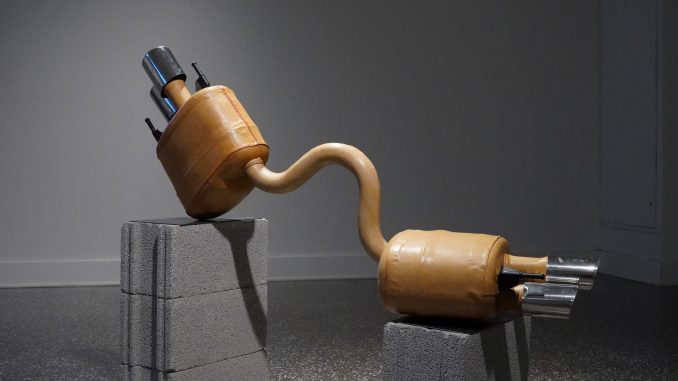
While language is known to be a valuable tool for self expression and communication, its role as an oppressive force is one that has often been overlooked. In exploration of the relationship between language and oppression, the Dorsky Museum on the SUNY New Paltz campus presented a collection of language-centered works entitled Mis/Communication: Language and Power in Contemporary Art, which was on display from June 15-Nov. 3. The exhibition was curated by Stony Brook art history and criticism Ph.D. student Amy Kahng, featuring a blend of sculptures, videos and interactive displays.
The curation featured works by Carmen Argote, Frédéric Bruly Bouabré, Jesse Chun, Jisoo Chung, Dahn Gim, Jennifer Chia-Ling Ho, Dulce Soledad Ibarra, Jake Duczynski and Angelina Joshua, Gala Porras Kim, Christine Sun Kim and Thomas Mader, Benjamin Lundberg Torres Sánchez, Kim Schoen, Clarissa Tossin and Han Yohan, which together demonstrated the ways in which language has been wielded to create hardships for global minorities and artists alike.
One of the most important themes spanning many of the artworks was the idea of colonialism and the way it has robbed many indigenous groups of their native languages. Brazilian artist Clarissa Tossin’s piece entitled Vogais Portuguesas/Portuguese Vowels was an outstanding exemplar of this. Tossin created five sugar molds of her mouth while pronouncing the Portuguese vowels a, e, i, o and u, highlighting Portugal’s imperialist history within Brazil.
“Portuguese is the national language in Brazil, which is obviously not where Portuguese originates,” said museum education manager Zachary Bowman. “It’s a language that was brought over and enforced through colonialism.”
Bowman also noted the importance of the material being sugar. “There’s a long history of the sugar trade, which involves enslaved labor, raping and pillaging land,” he said.
To culminate the Mis/Communication exhibition’s time in the Dorsky, SUNY New Paltz faculty members Reva Wolf (art history), Michelle Woods (English) and Mercedes Rooney (French) hosted a panel discussion on the way translation and censorship can distort and miscommunicate an artist’s intended meaning. They explored the case of Andy Warhol, a gay American artist who was active in the mid 1900s when homosexuality was illegal in the United States. Many of his words were twisted or excluded in order to make his works more palatable to a broad global audience.
“You see a lot of censorship in translation, sometimes by changing words and other times by just omitting things, leaving them out,” said Wolf, referring to multiple instances in which Warhol’s gay identity was suppressed by translators, such as one occurrence in which the word “queer” was translated into the word “weird.” At the end of the discussion, Wolf distributed signed copies of Translating Warhol, the book she recently edited, which delves deeper into the miscommunication of Warhol’s ideas.
Although the Mis/Communication curation is no longer stationed at the Dorsky for viewing, its lessons remain relevant. The role that language plays in society’s power dynamics is deep rooted, and fighting for free speech in a world full of censorship is as important as ever.
